|
|
|
Pacific Institute Launches New Website and Blog
The Pacific Institute launched a new, updated website at www.pacinst.org highlighting critical issues of the world's water and environmental and social justice. The new site provides information, publications, and resources and tools focused on eleven critical issue areas including the human right to water, sustainable water management, corporate water stewardship, and environmental health and justice.
The Institute has also launched a new blog, Pacific Institute Insights, which features detailed conversations and critical analyses authored by Institute staff and in the near future, featured guest bloggers.
For 25 years, the Institute's research has brought together stakeholders at multiple levels. Our work has released trapped knowledge, turning information that once circulated only among researchers and experts into data, concepts, and tools that decision-makers - from the household and community level to government and international coalitions - can use to tackle key challenges. The new website and blog makes this research more accessible and searchable than ever before.
We invite you to explore the new website and check Pacific Institute Insights regularly for fresh perspectives on these important topics from Pacific Institute staff. Feel free to share your thoughts by commenting on our blog posts featured in the right column of every online update.
|
|
Pacific Institute Releases First Report of New Series on California Water Rates and the "New Normal"
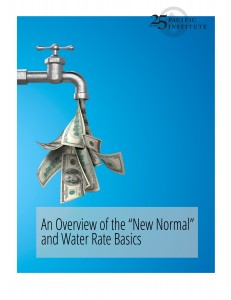 California is facing new challenges to sustainable water management, particularly when it comes to financing. Climate change, increasing costs, and an uncertain economy mean that water service providers can no longer rely on past levels of supply, consumption, or revenue to predict future conditions. An Overview of the New Normal and Water Rate Basics analyzes different rate structures that can be used to accommodate this "new normal" so that a utility is able to meet costs and ensure resiliency in an uncertain future. California is facing new challenges to sustainable water management, particularly when it comes to financing. Climate change, increasing costs, and an uncertain economy mean that water service providers can no longer rely on past levels of supply, consumption, or revenue to predict future conditions. An Overview of the New Normal and Water Rate Basics analyzes different rate structures that can be used to accommodate this "new normal" so that a utility is able to meet costs and ensure resiliency in an uncertain future.
There is no "one-size-fits-all" rate structure: the structure must be able to meet the goals and implementation capacity of the utility. "Water managers face the challenge that conservation-oriented rates may result in some level of fiscal variability. But accurate analysis, thoughtful planning, and effective communication can foster resiliency, both of the water resource and of the utility's financing, in the face of these changing conditions, "said Kristina Donnelly, lead author of the first white paper in the series.
To help rate-payers understand how their water is priced, and to help water managers who are involved in the planning and communication of water rate structures, the Pacific Institute white paper also provides case studies that highlight some of the challenges associated with adopting new rate structures. These include Carmichael Water District's change from a flat fee to a volumetric rate structure; the Moulton Niguel Water District's move to a water budget-based rate structure; and the City of Pasadena's move to a three-tiered water rate structure.
Read more on the Institute's work on water rates.
Download the white paper.
Download the "Need To Know: Water Rates" series briefs.
|
|
|
From
Pacific Institute Insights
Blogs
Peter Gleick's National Geographic's ScienceBlogs
|
|
|
|
|
Revised Curriculum Guide Supports Communities Grappling with Freight Transport Issues
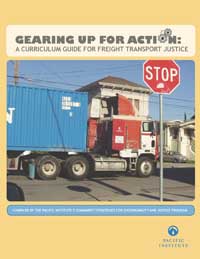 The Pacific Institute's revised Gearing Up for Action: A Curriculum Guide for Freight Transport Justice is an important advocacy tool to build the power and capacity of communities to participate in decision mak ing around freight transport issues. The activities have been designed to help community leaders engage groups of community members to learn more about freight transport and connect it to their own lives. The goal of our freight transport justice work is to reduce the adverse health impacts of freight transportation on low-income neighborhoods of color closest to freight transport hubs, and to increase the share of the benefits that residents of these communities enjoy. The Pacific Institute's revised Gearing Up for Action: A Curriculum Guide for Freight Transport Justice is an important advocacy tool to build the power and capacity of communities to participate in decision mak ing around freight transport issues. The activities have been designed to help community leaders engage groups of community members to learn more about freight transport and connect it to their own lives. The goal of our freight transport justice work is to reduce the adverse health impacts of freight transportation on low-income neighborhoods of color closest to freight transport hubs, and to increase the share of the benefits that residents of these communities enjoy.
The project began in 2009, when the Institute's Community Strategies for Sustainability and Justice Program began sharing the popular-education-style training, research, and advocacy tools for freight transportation justice that we had developed over five years with organizations and coalitions in other freight transport corridors and major hubs in the United States. The first edition of Gearing Up for Action came out in October 2010 to an enthusiastic reception, and the 2013 update is available now in both in English and Spanish.
Read more.
Download the guide in English (PDF)
Download the guide in Spanish (PDF)
|
|
First of-Its-Kind Research Analyzes the Extent of Irrigated Agriculture in the Colorado River Basin States
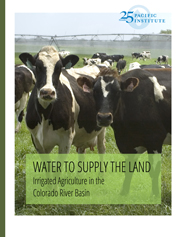 The Colorado River, recently named America's most endangered river, supports millions of people in the American Southwest and northwest Mexico and helps irrigate millions of acres of land. Yet demands on the river already exceed the river's average supply, with irrigated agriculture consuming more than 70% of the water supply within the basin. The Colorado River, recently named America's most endangered river, supports millions of people in the American Southwest and northwest Mexico and helps irrigate millions of acres of land. Yet demands on the river already exceed the river's average supply, with irrigated agriculture consuming more than 70% of the water supply within the basin.
For the first time, new research from the Pacific Institute describes the extent of irrigated agriculture throughout the seven Colorado River basin states and two additional states in Mexico, the types of crops grown, and the amount of water used to grow these crops. In addition, the new report - Water to Supply the Land: Irrigated Agriculture in the Colorado River Basin - compares several agricultural management scenarios and the potential water savings and costs associated with each. Importantly, none of the scenarios remove agricultural land from production.
"We know water supply and demand don't match up and it will get worse going forward. We know there is much that can be done; the question is how much and where, and how to get there," said Michael Cohen of the Pacific Institute, lead author of the report which has already been downloaded over 18,700 times. "This analysis improves understanding of crop acreages and water use in the basin and offers a set of plausible scenarios in which some of the water currently devoted to irrigation could be conserved and used for other purposes - without taking agricultural land out of production."
Read more.
Download the full report.
Download the Executive Summary.
View the interactive map.
|
|
New Report on Groundwater Dynamics in the Colorado River Limitrophe - Available in English and Spanish
Este reporte tambi�n est� disponible en espa�ol, aqu�.
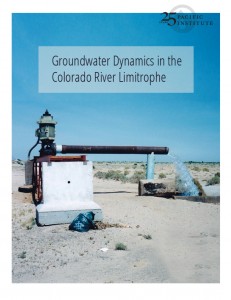 The Colorado River, diverted and channelized and intensively managed, only rarely has enough water to flow even 20 miles past Morelos Dam, the last dam on the river, near the California/Arizona/Baja California border. The river's limitrophe reach is the roughly 22.5 mile stretch from Andrade to San Luis that separates Baja California from Arizona and is generally considered the uppermost extent of the remnant Colorado River delta. The Colorado River, diverted and channelized and intensively managed, only rarely has enough water to flow even 20 miles past Morelos Dam, the last dam on the river, near the California/Arizona/Baja California border. The river's limitrophe reach is the roughly 22.5 mile stretch from Andrade to San Luis that separates Baja California from Arizona and is generally considered the uppermost extent of the remnant Colorado River delta.
Groundwater Dynamics in the Colorado River Limitrophe describes and explains the changing groundwater conditions in and adjacent to the Colorado River's limitrophe reach, and analyzes the impact of groundwater pumping on these overdraft conditions. The key question underlying this study asks how changing groundwater conditions in the limitrophe could affect the sustainability of planned habitat restoration projects.
This study indicates that, even after the exceptionally dry period of 2005-2009, when surface flows failed to reach the gage at the downstream end of the limitrophe on 90 percent of days, more than a third of the channel through the limitrophe still exhibited connectivity with the water table, and roughly two-thirds of the limitrophe still had a water table that remained within the reach of the roots of cottonwoods and willows. The plunging water table at the downstream end of the limitrophe suggests that the final five miles of the river within the limitrophe may not respond to efforts to restore riparian habitat, at least not without a long-term commitment to supplemental irrigation, but areas upstream appear well-insulated from the recent drawdown and would benefit from restoration activity, such as that proposed by the recent Minute 319.
Read more.
Download the report (PDF).
Lee el reporte Din�mica del Agua Subterr�nea en el Tramo Lim�trofe del R�o Colorado (PDF).
|
Share Your Thoughts: Barriers to Water-Energy Conservation Programs Survey

If you have experience working on (or trying to work on) coordinated water and energy conservation programs, please take a few moments to share your thoughts by filling out the survey: https://www.surveymonkey.com/s/L3CH77F. Results of the survey, along with several case studies of coordinated programs, will be released in a report this summer. Thank you in advance for your time!
Take the survey.
|
|
Peter Gleick Testifies Before the California Assembly Select Committee on Sea-Level Rise and the California Economy
The reality of climate change will affect California in many ways, from rising temperatures to changes in fire frequency, drought and flood risks, threats to agricultural production and our water resources, and especially, growing damage and destruction along our extensive coastline from rising sea levels. On May 15, Pacific Institute President Peter Gleick testified before the California Assembly Select Committee on sea-level rise and the California economy.
Over the past century, sea level has risen nearly eight inches along the California coast, and climate science research suggests very substantial additional increases in sea level over the coming century. The Pacific Institute, with support from the State of California, completed a detailed analysis of the current population, infrastructure, and property at risk from projected sea-level rise if no actions are taken to protect the coast.
Continue reading.
Download Dr. Gleick's presentation from his testimony.
|
Using Photo-Voice to Engage Youth in Creating Healthier Communities
Through the Institute's partnership with Communities United for Restorative Youth Justice (CURYJ), we are tapping into the power of picture-taking to engage young people in generating innovative solutions that address the root causes of violence in their communities. Launched in March 2013, the Institute's photo-voice project works with Native American and Latino youth who are involved in after-school programming at the Intertribal Friendship House and at Dewey Academy, an alternative continuation high school in Oakland. The Pacific Institute's Community Strategies for Sustainability and Justice (CSSJ) Program partnered with CURYJ to develop a popular-education-style training series that builds skills youth need to participate in each step of the photo-voice project. These steps include identifying themes based on shared experiences, taking photos that illustrate these themes, grouping and analyzing photos based on themes, and writing captions to accompany the photos. In addition to gaining research skills, youth involved in both projects receive a stipend to support their participation in the projects. For more information please contact Program Director Catalina Garz�n at [email protected].
|
|
Report from Circle of Blue
 Circle of Blue, an affiliate of the Pacific Institute, is the international network of journalists, scholars, and citizens that connects humanity to the global freshwater crisis. Circle of Blue, an affiliate of the Pacific Institute, is the international network of journalists, scholars, and citizens that connects humanity to the global freshwater crisis.
On the frontlines with Circle of Blue - Choke Point: India
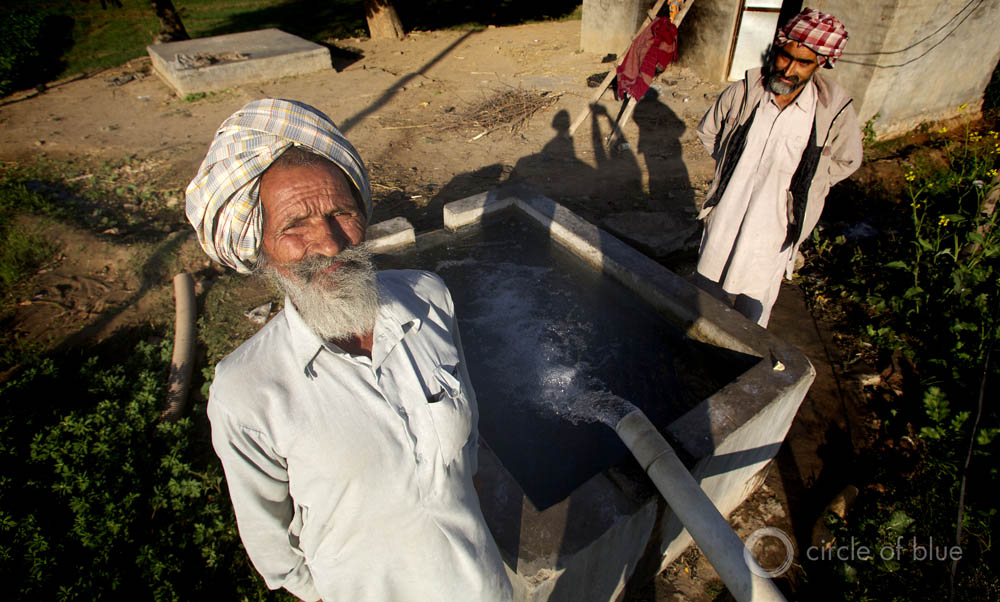 | | Photo: � J. Carl Ganter/Circle of Blue |
The Green Revolution that catalyzed grain production in the mid-1960s ended India's fear of famine. But achieving food abundance is overwhelming India's mammoth and unwieldy bureaucracy, draining its freshwater reserves, and straining the energy sector and electrical grid. This week, Circle of Blue, in collaboration with the Wilson Center China Environment Forum, begins an in-depth look at India's water, food and energy challenges. Read the first in the series, "Choke Point: India - The Leopard in the Well."
Read More.
|
|
In Brief
High Level Public Officials from China Visit the Institute
A visiting group from China's National Development Research Council's Academy of Macroeconomic Research visited the Institute at the beginning of June to discuss issues of urban development and environmental policy with staff members. Staff members spoke on urban water issues in California and the Western United States, the Institute's research efforts, and climate adaptation.
Pacific Institute staff members gave talks and lectures, conducted workshops, and participated on panels far and wide this month. Here are some of the places we've been: \
Heather Cooley, Water Program Co-Director:
- presented at the Association of California Water Agencies Spring Conference in Sacramento, California. Her presentation focused on water rates and conservation and efficiency.
- attended the Commercial, Industrial, and Institutional Task Force meeting to finalize the Task Force's report that will be given to the state legislature this year.
Peter Gleick, President:
- participated on a panel at the Asia Society Northern California event, Water Wars in Asia? - gave the keynote talk at the US National Academy of Sciences Water/Energy sustainability meeting
Jason Morrison, Corporate Sustainability Program Director:
- represented the CEO Mandate Water at a CEO Roundtable focusing on Water Security and Green Growth in the Asia-Pacific Region. Co-organized by the Asia Development Bank, WWF International, and the CEO Water Mandate, and attended and led by the Deputy Prime Minster of Thailand, Plodprasop Suraswadi, the CEO Roundtable side event was part of the Asia-Pacific Water Summit being held in Chiang Mia, Thailand.
- presented the CEO Water Mandate's work at the 20th meeting of the United Nations Secretary-General's Advisory Board on Water and Sanitation (UNSGAB) held in Milano, Italy. UNSGAB invited representatives of global initiatives on water stewardship to an open exchange in order to identify cross-linkages and synergies with UNSGAB's work with the ultimate goal of providing advice to the Secretary General on this emerging paradigm as well as shape the future agenda for water stewardship vis-�-vis UN Member States. The Advisory Board was also trying to determine whether and how to include a water stewardship-related objective in its 2-3 year plan of action currently under development.
Dr. Juliet Christian-Smith, Senior Research Associate:
-attended the California Roundtable on Water and Food Supply meeting in Davis, CA.
|
|
Upcoming Events
- June 12: Summit on Regulations Affecting Agriculture
Dr. Juliet Christian-Smith, Senior Research Associate in the Water Program, will be speaking about the Institute's farm water success stories on June 12 at the Summit on Regulations Affecting Agriculture at the University of California - Davis. Hosted by Ag Innovations Network, this Summit is the culminating meeting of a project that has sought to identify a broadly supported set of recommendations to simultaneously assure high environmental performance and the viability of farming operations at all scales.More details are available at http://aginnovations.org/regulations/summit/
Date:Wednesday, June 12
Location: Freeborn Hall, UC Davis, Davis, CA 95616
Register online or contact Serena Coltrane-Briscoe at [email protected] or 707.823.6111 �220 for more information.
- June20: Presentation of the Water Demand Forecasting Tool
Dr. Christian-Smith will also be presenting the Institute's water demand forecasting tool at the California Urban Water Conservation Council plenary on June 20.
Location:Tsakopoulos Library Galleria, Sacramento
Time: 9:30am-3:30pm
- June 21: Training-of-Trainers on Popular Education Tools
The Pacific Institute and the Ditching Dirty Diesel Collaborative will be co-hosting a Training-of-Trainers on Popular Education Tools for Community Health for community organizers, outreach workers, and health educators on June 21. The training will share activities and materials from our Gearing Up for Action curriculum guide that can build the capacity of community residents to take action to address the impacts of diesel pollution and freight transport operations on community health and quality of life.
Using a Popular Education approach and activities from Gearing Up for Action, the training will give par
ticipants tools to:
- Elevate the lived experiences of community members they work with;
- Make connections between the work of their organization and the impacts of trucks and trains in the communities they work in;
- Enable community members to envision and advocate for healthier communities.
When: Friday, June 21, 9am- 5pm
Where: Pacific Institute, 654 13th Street (at MLK), Preservation Park, Oakland, CA 94612
Contact: Catalina Garzon, [email protected] or 510.251.1600
Register here.
Space is limited! Please register here if you plan on attending as we are tailoring the training to the particular issues and campaigns that participants are working on. Lunch and snacks will be provided.
|
|
In the News
Peter Gleick spoke with Neela Banerjee from the Los Angeles Times about climate change and its effect on droughts, based on research from the Institute. Read the article.
Jason Morrison was quoted in this article by National Geographic on corporate water stewardship in the beer brewing industry.
Rachel Lake had a conversation with Peter Gleick as Part Seven in a series entitled The Brick Project Conversations. These conversations explore ideas that relate to education for children and the community building that nurtures and encourages progress in childhood education around the world. Read the conversation.
|
|
|